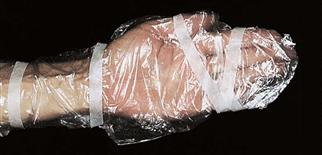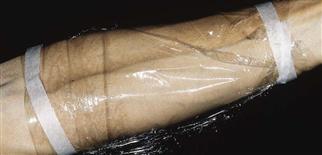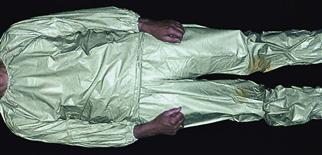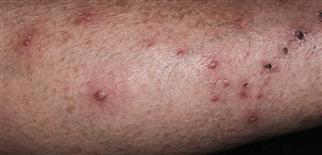Topical corticosteroids

Plastic wrap (e.g. Saran Wrap) with paper tape is an effective method to increase penetration of topically applied medications.

Ace wrap can be applied on top of this plastic wrap to help keep the wrap in place.

Occlusion of the entire body. A vinyl exercise suit is a convenient way to occlude the entire body.

Occlusion for extended periods of time may result in secondary infection with pustules and Staphylococcal folliculitis. Occlusion is stopped and the patient is treated with oral antibiotics.
DESCRIPTION
• Topical corticosteroids: used to treat inflammatory dermatoses; safe and effective with proper use. • Corticosteroid potency: organized into seven groups based on their anti-inflammatory activity; group I (strongest) to group VII (weakest).
GENERAL FACTS AND GUIDELINES
Important factors to consider when choosing steroid strength are diagnosis, location, age, and patient’s financial resources. Two weeks is adequate to see a clinical response. Steroid concentrations reflect relative strength for a particular corticosteroid (triamcinolone 0.025%, 0.05%, 0.1%) and cannot be used to compare strengths between corticosteroids. Fluorinated steroids (containing a fluorine atom) have an increased potency and a tendency for side effects. • Superpotent topical corticosteroids (group I): use less than 45−60 g per week; use cyclic dosing (2 weeks of therapy followed by 1 week of rest); prescribe limited amounts; use for plaque psoriasis and hand or foot eczema. • Group II−VII topical corticosteroids: avoid undertreatment with weak group VII topical corticosteroids (hydrocortisone) for more difficult rashes; eyelid dermatitis and intertriginous areas respond quickly to group VI or VII steroids.
METHODS OF APPLICATION
Simple
Firmly massage thin layer of topical corticosteroid into the skin without the aid of an occlusive dressing. Washing is not necessary before each application.
Occlusive
Occlusive dressings (e.g. Saran Wrap) hydrate the stratum corneum and allow enhanced corticosteroid absorption; allow for use of lower-strength corticosteroids. Occlusive dressings can be used during the day for periods up to 2 h, or 8 h during sleep. Simple applications can be alternated with applications assisted by an occlusive dressing. Vinyl exercise suits (sauna suits) are effective to occlude large body surface areas. • Complications of occlusive dressings: infection, folliculitis, and miliaria
STEROID−ANTIBIOTIC MIXTURES
Antifungal–corticosteroid combinations (Mycolog, Lotrisone) are expensive and have limited uses. The topical corticosteroid betamethasone dipropionate found in Lotrisone is too strong for intertriginous areas and can cause permanent striae.
POTENTIAL SIDE EFFECTS OF TOPICAL CORTICOSTEROIDS
• Allergic contact dermatitis, burning, itching, irritation, dryness (largely due to the vehicle), hypertrichosis, hypopigmentation, miliaria and folliculitis, skin breakdown, glaucoma, cataracts, rebound phenomenon (i.e. psoriasis becomes worse after treatment is stopped), rosacea, perioral dermatitis, acne, skin atrophy with telangiectasia, stellate pseudoscars (arms), purpura, striae, skin blanching from acute vasoconstriction, systemic absorption, tinea incognito, impetigo incognito, scabies incognito. • Infants are at increased risk for systemic absorption.







